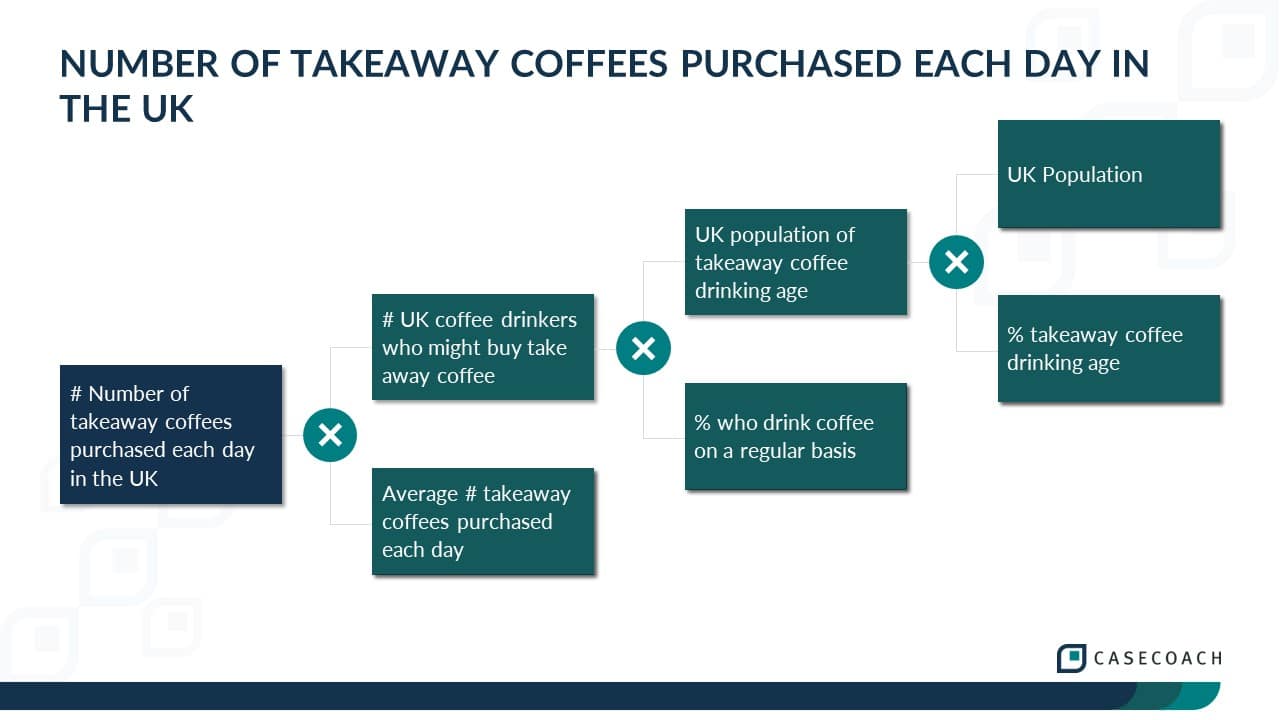Management consulting firms and other employers sometimes use market sizing questions – also known as estimation questions – as a standalone interview format to assess candidates on a wide range of problem-solving dimensions.
In a market sizing interview, you might be asked to estimate figures such as:
- the revenue of a sandwich store
- the number of ATMs in Beijing
- the size of the market for lattes in the US
- the number of newspapers sold in Spain
Often, sizing a market is also part of solving a case interview question.
Given the prevalence of these questions, the ability to size a market or estimate a number successfully is an essential part of the toolkit for any candidate interviewing for a strategy role.
In this article, we share the seven steps that will help you nail any market sizing question.
1. Clarify the problem
The first thing to do is to clarify both the question and the scope of the answer. After all, you don’t want to start sizing the wrong market.
Make sure that you confirm the key parameters of the question, such as:
- whether the answer needs to be in units or currency
- what the relevant time frame is
- what type of product is in question
If the question is “What is the number of takeaway coffees purchased per day in the UK?”, you might want to clarify whether you should only look at takeaway coffees bought from a store or whether you should take vending machine coffees into account.
2. Choose a top-down or bottom-up approach
Market sizing questions can be solved using either a top-down or bottom-up approach.
The top-down approach
The top-down approach involves starting with large, macro numbers and working your way down to smaller figures. For example:
- Begin with the population of the relevant country.
- Identify some segments based on age.
- Estimate the propensity of each age group to buy the product in question.
- Make some assumptions about how frequently these people make purchases.
In the takeaway coffee example, this may mean starting with the overall population, estimating the percentage of coffee drinkers, and then estimating the number likely to buy takeaway coffees.
The bottom-up approach
The bottom-up approach involves starting with small numbers and working your work up to larger figures. For example:
- Begin by considering how many vendors there are in any given locality.
- Estimate the sales that go through each vendor.
- Scale that up to the population at large.
In the takeaway coffee example, you might estimate the number of coffees bought per coffee shop, then the number of coffee shops per town, and then multiply that figure by the number of towns in the country.
You may have a personal preference for using either a top-down or bottom-up approach. Usually, either can work.
3. Set up your structure
Once you’ve chosen your approach, you need to structure it. This involves figuring out the formula or equation that’s going to get you to your final number, and representing it in a logic tree.
Here, you need to strike the right balance between complexity and accuracy. A common mistake is to create a highly complex formula that captures every minute variable. This is a pointless effort, as your result will rely on your own assumptions, and will therefore only be an approximate answer. You should therefore ignore any variable that doesn’t make a significant difference.
On the other hand, another common mistake is to be overly simplistic. This usually results in candidates missing important drivers and ending up in the wrong ballpark.
So how could you get to the number of takeaway coffees bought from a store every day in the UK? Here’s an example of what this approach could look like:

Once you’ve set up your structure, be sure to share it with your interviewer before you start performing your calculations.
4. Use segmentation
It’s likely that your structure will require you to make assumptions about some numbers. Your best guess is likely to be roughly right in some cases. In others, it’s likely to be significantly off the mark, and this is when segmentation can help.
By breaking down the number that you’re trying to estimate into several segments and then making an estimate for each segment, you’ll get to a more accurate number.
In the coffee example, when you come to estimate the number of takeaway coffees purchased per person per day, you could segment the market into three types of coffee drinkers:
- Those who love a daily takeaway coffee
- Those who buy a takeaway coffee once a week
- Those who prefer to make coffee at home
You could then assign a percentage of the population to each segment and calculate a weighted average.
5. Make the right assumptions
In any given market sizing question, you’ll need to make assumptions about certain figures, such as population sizes, the number of households, and the average number of children per family. Your interviewer will typically give you some information that’s relevant to the case. However, beyond this, you’ll need to make assumptions and apply your own judgment.
If your assumptions are too far off the mark, you’re unlikely to reach a sensible answer and may even look a bit silly in front of the interviewer. If you want to avoid this, there are some key facts you should learn as part of your interview preparation. These include:
- populations of key countries
- average life expectancy
- the average number of people per household
- median income
- GDP growth rate
- inflation rate
- the base interest rate
Rounding these figures is perfectly fine – just make sure they’re in the ballpark of logic and sense!
In the coffee question, you might volunteer that the UK population is roughly 60 million and then estimate that 75% of the population is in the age range for buying takeaway coffee.
6. Get the calculations right
As with any type of case question, a firm grasp of a few core mathematical principles is vital for getting the calculations right in a market sizing question.
You must be able to handle basic operations – addition, subtraction, multiplication and division, including long division – on paper. You must also be able to solve math problems using key concepts such as fractions, percentages, compounding, weighted averages, probability, and algebra.
Case interviews require candidates to demonstrate only a high school level of math skills. However, with no calculators allowed and an interviewer looking over their shoulder, many people find this aspect of the interview challenging.
The good news is that mental arithmetic is one of the case interview skills you can practice alone as part of your preparation, using drills. These are interactive exercises that pose rapid-fire questions and then provide instant feedback. Our Consulting Interview Prep Toolkit includes a comprehensive set of these drills.
It also includes a dedicated Case Math Course with 21 video classes that cover the following areas in detail:
- The four operations: addition, subtraction, multiplication, and division
- The key math concepts you’ll need to master, such as fractions, percentages and weighted averages
- ‘Pro-tips’ for doing well in case math, including keeping track of zeros and simplifying calculations
- Business math concepts such as cash flow, investments and valuations
7. Sanity-check your answer
When you reach an answer, be sure to check whether it makes sense and that your final number is neither too large nor too small. Do this by comparing it to other figures you know.
In the takeaway coffee question, would it be reasonable to say that 100 million coffees are purchased every day in the UK if there are only 60 million people in the country?
If your solution doesn’t look right, you may have miscalculated or made a wrong assumption, so review your approach and correct any mistakes before sharing your answer with your interviewer.
How to practice market sizing questions
It’s vital to prepare thoroughly for every aspect of interviewing at a top consulting firm. The best way to practice market sizing and estimation questions is our Market Sizing Drills. You’ll also find several market sizing practice cases with solutions in our Case Library. Both the Drills and Case Library are included as part of our Consulting Interview Prep Toolkit.







